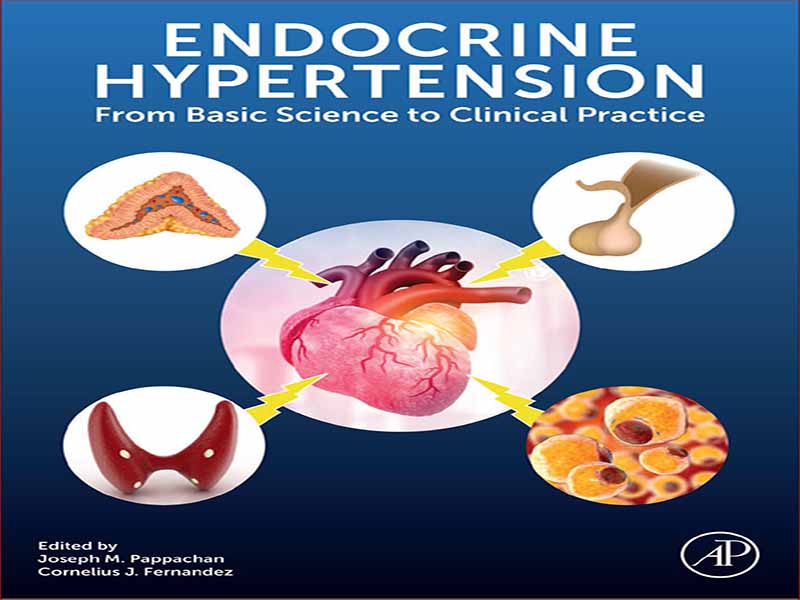- عنوان کتاب: Endocrine Hypertension From Basic Science to Clinical Practice
- نویسنده: Ernesto L. Schiffrin
- حوزه: غدد درون ریز
- سال انتشار: 2023
- تعداد صفحه: 412
- زبان اصلی: انگلیسی
- نوع فایل: pdf
- حجم فایل: 12.4 مگابایت
علل غدد درون ریز فشار خون یکی از شایع ترین علل فشار خون ثانویه است، و با تشخیص افزایش شیوع آلدوسترونیسم اولیه، می تواند درصد قابل توجهی، شاید تا 20٪ از علل فشار خون بالا را نشان دهد. تشخیص دقیق این شرایط به دلیل عوارض ناشی از تداوم بیماری در مواردی که تشخیص داده نمی شود بسیار مهم است و به دلیل اینکه بسیاری از این بیماری ها ممکن است درمان شوند، بر خلاف فشار خون اولیه که می توان آن را کنترل کرد اما در آن درمان نشد. زمان حال دستورالعملهایی برای تشخیص و درمان پرفشاری خون غدد درون ریز از بسیاری از سازمانها، مانند انجمن غدد درون ریز ایالات متحده، دستورالعمل AHA/ACC 2017، و آخرین دستورالعملهای اروپایی، هر دو برای مدیریت فشار خون به طور کلی، اما شامل توصیههایی برای فشار خون غدد درون ریز، و بسیاری از منابع توصیه های دیگر که شامل نحوه تشخیص و مدیریت فشار خون غدد درون ریز می شود. با این حال، نیاز به یک رساله در مورد فشار خون غدد درون ریز وجود دارد که به طور عمیق به علت شناسی، پاتوفیزیولوژی و زیربنای مولکولی، تشخیص افتراقی، و مدیریت فشار خون غدد درون ریز، از جمله جنبه های عملی تر درمان و پیگیری بپردازد. فشار خون غدد درون ریز، از علوم پایه تا تمرین بالینی، ویرایش شده توسط جوزف ام. پاپاچان و کورنلیوس جیمز فرناندز دقیقاً این کار را انجام می دهد. با فصل X نوشته شده توسط مقامات در این زمینه، Hypertension غدد درون ریز توصیف عمیقی از تمام جنبه های فشار خون بالا با مفاهیم غدد درون ریز ارائه می دهد. از هیپرپلازی آدرنال تا آکرومگالی، و از پاراگانگلیوما و فئوکروموسیتوم تا کوشینگ، از طریق هیپرآلدوسترونیسم در انواع مختلف آن گرفته تا نقش سیستم رنین-آنژیوتانسین و بسیاری از اشکال فشار خون مونووژنیک، هیچ جنبه ای از فشار خون غدد درون ریز بررسی نشده باقی نمانده است. ژنتیک، جنبههای مولکولی و سلولی، اتیوپاتوژنز، پاتوفیزیولوژی، توصیف بالینی، غربالگری و تشخیص، و در نهایت مدیریت و پیگیری شامل نکات عملی، همگی با نثری واضح و خواندنی مورد توجه قرار گرفتهاند که آن را نه تنها جذاب و سرگرمکننده میسازد، بلکه بسیار هم جذاب میکند. به راحتی در تمرین روزمره گنجانده می شود. بعد از فصلهای مربوط به کاتکول آمینها و سیستم رنین-آنژیوتانسین، فصلهایی درباره فئوکروموسیتوم، پاراگانگلیوما و اشکال مختلف فشار خون آدرنال، از جمله یافتههای اخیر در مورد خوشههای سلولی تولیدکننده آلدوسترون و جهشهای جسمی در ژنهای کدکننده کانالهای یونی و ATPases موجود در سلولهای آلدوسترون وجود دارد. خوشهها و تمام ناهمگنیهای ژنتیکی، سلولی و مولکولی در آدرنالها با آدنوم تولیدکننده آلدوسترون، از جمله اشکال خانوادگی آلدوسترونیسم اولیه. اشکال نادر فشار خون غدد درون ریز مانند آکرومگالی و سندرم کوشینگ، و همچنین اشکال تک ژنی فشار خون بالا، نیاز به شک بالینی بالایی دارند، اما مهم است که آنها تشخیص داده شوند. همین امر در مورد تصور فراوانی آلدوسترونیسم اولیه نیز صدق می کند، که در بیشتر موارد فشار خون بالا نیاز به آزمایش دارد، زیرا اغلب تظاهرات ظریف تری نسبت به سندرم کان کلاسیک دارد و تشخیص و درمان آن می تواند برای بیماران بسیار خوشحال کننده و مفید باشد. پیشگیری از آسیب و عوارض اندام هدف هر کسی که به فشار خون بالا علاقه دارد، از ژنتیک گرفته تا پاتوفیزیولوژی و تظاهرات مولکولی و سلولی گرفته تا تشخیص و درمان، باید به فشار خون غدد درون ریز علاقه مند باشد و اگر می خواهد دانش کافی از این شرایط داشته باشد و قادر به انجام تشخیص و مدیریت مبتنی بر شواهد باشد، باید این جلد را مطالعه کند. بیماران مبتلا به فشار خون، که بسیاری از آنها نوعی فشار خون غدد درون ریز، اغلب آلدوسترونیسم اولیه، اما گاهی اوقات برخی از اشکال نادر فشار خون غدد درون ریز را دارند.
Endocrine causes of hypertension are among the most frequent causes of secondary hypertension, and with the recognition of the increased prevalence of primary aldosteronism, could represent a sizable percentage, perhaps up to 20% of the aetiologies of hypertension. Accurate diagnosis of these conditions is critical because of the complications associated with the persistence of disease in cases in which diagnosis is not made, and because many of these conditions may be cured, in contrast to primary hypertension, which can be controlled but not cured in present times. There are guidelines for diagnosis and treatment of endocrine hypertension from many organizations, such as those of the Endocrine Society of the USA, the 2017 AHA/ACC Guideline, and the latest European Guidelines, both for the management of hypertension in general but including recommendations for endocrine hypertension, and many other sources of recommendations that include how to diagnose and manage endocrine hypertension. However, there is a need for a treatise on endocrine hypertension that addresses in-depth the etiology, pathophysiology and the molecular underpinnings, the differential diagnosis, and the management of endocrine hypertension, including the more practical aspects of treatment and follow-up. Endocrine Hypertension, from Basic Science to Clinical Practice, edited by Joseph M. Pappachan and Cornelius James Fernandez does precisely that. With X chapters written by authorities in the field, Endocrine Hypertension provides an indepth description of all aspects of hypertension with endocrine connotations. From adrenal hyperplasia to acromegaly, and from paragangliomas and pheochromocytoma to Cushing’s, through hyperaldosteronism in its different types to the role of the renin-angiotensin system and the many forms of monogenic hypertension, no aspect of endocrine hypertension is left unexamined. The genetics, molecular and cellular aspects, etiopathogenesis, pathophysiology, clinical description, screening, and diagnosis, and finally management and follow-up including practical tips, all are addressed in clear and readable prose that makes it not only attractive and entertaining but also hugely easy to incorporate into everyday practice. Chapters on catecholamines and the renin-angiotensin system are followed by ones on pheochromocytoma, paragangliomas and different forms of adrenal hypertension, including recent findings on aldosterone-producing cell clusters and somatic mutations in genes encoding for ion channels and ATPases found in aldosteronomas and aldosteroneproducing cell clusters, and all the genetic, cellular, and molecular heterogeneity in adrenals with an aldosteroneproducing adenoma, including the familial forms of primary aldosteronism. Rarer forms of endocrine hypertension such as acromegaly and Cushing’s syndrome, as well as the monogenic forms of hypertension, require high clinical suspicion but it is important that they be diagnosed. The same applies to the notion of the high frequency of primary aldosteronism, which requires testing in most cases of hypertension because it often has more subtle manifestations than the classical Conn’s syndrome, and its diagnosis and treatment can be extremely gratifying and beneficial to patients, with prevention of target organ damage and complications. Anyone interested in hypertension, from genetics to pathophysiology and molecular and cellular manifestations to diagnosis and treatment should be interested in endocrine hypertension and should read this volume if they want to have adequate knowledge of these conditions and be able to practice evidence-based diagnosis and management of hypertensive patients, many of whom will have some form of endocrine hypertension, very often primary aldosteronism, but occasionally some of the more rare forms of endocrine hypertension.
این کتاب را میتوانید بصورت رایگان از لینک زیر دانلود نمایید.
Download: Endocrine Hypertension From Basic Science to Clinical Practice



































نظرات کاربران